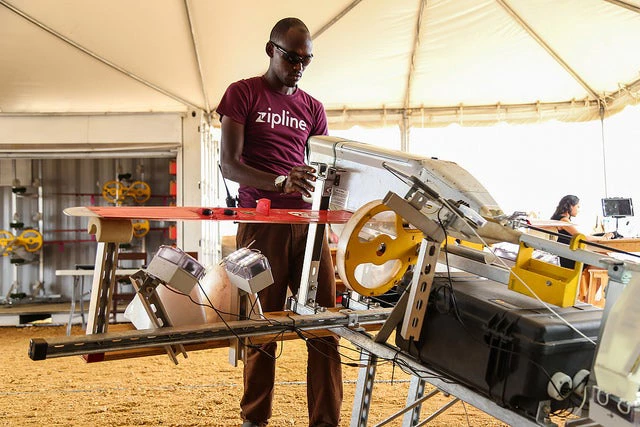
to use the drone technology at the service of saving lives. The drone delivery project is a partnership
between the Government of Rwanda and the California based robotics company, Zipline, Inc.
With the help of these drones, patients no longer have to wait for blood for hours to get to remote
clinics and hospitals. They can now receive blood transfusions in minutes.
Photo: Sarah Farhat / World Bank
Blood-delivering drones? Check. 3D-printer working off grid to print finger splints? Check. Disadvantaged women trained and employed in software-developing? Check. Is this how technology can deliver for development?
First things first. Let’s go back to the first principles. The World Bank’s World Development Report 2016 used a 3X3 framework to think about digital technology from a development lens: inclusion, efficiency and innovation for people, governments and businesses. Digital technologies, when employed as a tool for development, have the capacity to promote inclusive economies and societies, build upon existing capital and generate economies of scale. Herein lies powerful potential.
The Process: Stock-taking and Mind-boggling. As part of a joint project between Georgetown School of Foreign Service and The World Bank, Roberta Gatti, Erwin Tiongson and I spent much of the year “stock-taking” projects in the Technology and Human Development sector. This involved assigning projects into the following categories: education services, health services, labor/market entry programs and programs focused on women and girls. We explored the incredible wealth of projects and drew parallels and distinctions among target groups, methodology and reach. We examined the efficacy of Public Private Partnerships and confirmed the expansive reach made possible by the partnership between private sector, NGOs and local governments.
The breadth of what is happening is incredible, with boundary-pushing projects like PhilSmile, which enables mobile mediums of remittances; Laboratoria, which offers low-income women in Peru the opportunity to learn software development; and Zipline, a drone start-up delivering medical supplies in Rwanda. The results were so staggering that we could barely keep up with the ever-expanding environment—we were almost always experiencing some type of “disruption”. Ultimately, we identified the organizations and institutions that seemed on the “frontier” of the nexus of technology and development and best exemplified the WDR framework.
R2D2 and Mini-Drones. Anyone who has met Julielynn Wong, of 3D4MD, can spot her right away by her R2D2 backpack with a 3D printer inside. She proceeded to use the printer while giving her presentation, demonstrating effectively the ease and efficiency of the product. By the time she finished her presentation, a finger splint was produced and ready for use. She also noted that 3D printers can be self-replicating and subsequently, highly sustainable solutions for communities. Those communities are not limited to Earth alone: at the Mars Desert Research Station, Dr. Wong’s 3D printer used solar energy to print medical supplies for a crew on Mars!
David Bowen, of MEASURE, had another exciting product in tow: drones for development. While we understand some of the drawbacks of drones, we also understand their potential. These drones were minute enough to look like playthings, focusing on four core industries: Energy, Telecommunication, Architecture and Media. The drones help map property lines, monitor crops, inspect powerlines, provide disaster response relief and deliver medical supplies. Currently, there are 2,000 Measure-led flights in the U.S. and abroad.
Marianna Costa did not have any gadgets with her, but rather, a wealth of success stories from Laboratoria, her tech social enterprise that empowers women from low-income communities. Software development is one of the fastest growing sector in Latin America and faces a huge void in talent, particularly female talent. She saw a market opportunity that could address a social problem: women’s barriers to labor market entry. Laboratoria leverages the talent of young women through a software development “bootcamp” and has subsequently become the leading source of female tech talent out of South America, with over 600 successful graduates.
Technology: No longer a gimmick. Each organization represents the tremendous potential of development and technology’s nexus: opportunities are opened up, essential services are delivered to more places for less and communities are able to “leapfrog” in unprecedented ways. Technology is no longer a gimmick, but rather, a meaningful addition to amplify development potential.


Join the Conversation